Theories Models and Principles in E&T
25 Pages8358 Words457 Views
Added on 2020-10-05
Theories Models and Principles in E&T
Added on 2020-10-05
ShareRelated Documents
THEORIES MODELS ANDPRINCIPLES IN E&T
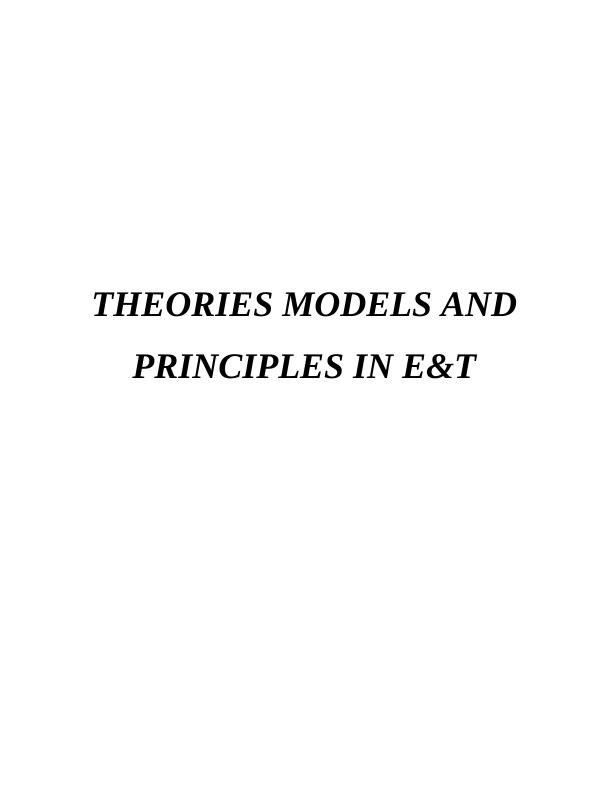
TABLE OF CONTENTSINTRODUCTION:..........................................................................................................................1TASK 1............................................................................................................................................1A Analyse theories and models of reflection and evaluation (5.1).............................................1B Theories and models of reflection can be applied to reviewing practice (5.2)........................4TASK 2............................................................................................................................................5Analyse theories, principles and models of learning and models of learning preferences (1.1and 1.3)........................................................................................................................................5Explain ways in which theories, principles and models of learning can be applied in teaching(1.2)...........................................................................................................................................10Explain how learning preferences enables inclusive teaching and learning (1.4)....................11TASK 3..........................................................................................................................................12A Analyse theories, principles and models of communication ................................................12TASK 4..........................................................................................................................................14A Analyse theories, principles and models of assessment (3.1)...............................................14B Explain ways in which theories, principles and models of assessment can be applied inlearning (3.2).............................................................................................................................15C Reflective journal on what has been learned (3.1)................................................................16TASK 5..........................................................................................................................................17A Analyzing theories and models of curriculum (4.1)..............................................................17B Applying the theories and models of curriculum (4.2)..........................................................19CONCLUSION .............................................................................................................................20REFERENCES :............................................................................................................................21
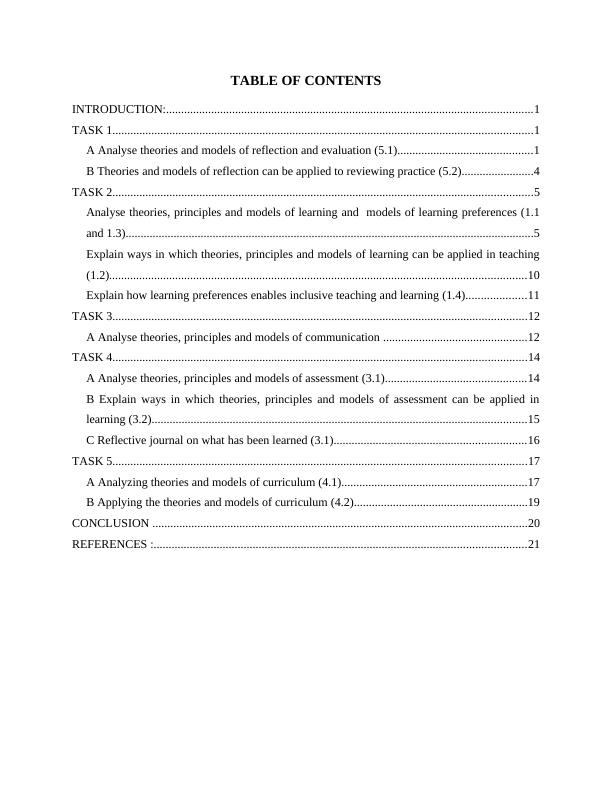
INTRODUCTION:An individual acquires education to become a successful person. Education providesbasis knowledge and learning that is required in career development. It provides learning invarious subjects. It is important for a person to evaluate his learning so that it can be enhanced(Ballantine, Hammack and Stuber, 2017) Besides this, a person must evaluate his or herperformance so that strengths and weaknesses can be found out. This will help an individual inimproving it. Besides this, reflection helps in knowing about current skills and ability andprogress of training. Moreover, a teacher helps an individual in learning. An individual canbecome an expert by strengthening his or her professional skills. Also, reflection is done byapplying some theories and models. This is because different model results can be applied invarious areas. This report will throw light on different theories and models of reflection.Moreover, it will show various models in curriculum development and how it can be applied onpractise. TASK 1A Analyse theories and models of reflection and evaluation (5.1)Reflection allows a person to grow and develop in professional discipline. It is a basis onwhich knowledge and learning can be evaluated. Apart from this, it becomes easy for person tomaintain progress by identifying weak areas and improving it. There are different models andtheories of reflection (Sommers-Flanagan, 2018). They all have their own meaning anddifferences. Besides this, models help in analysing what practise must be followed and evaluatesindividual performance. The models are described below:- Models of reflectionGibbs model of reflectionIt helps a person to identify his or her behaviour in a situation. It finds out that how aperson has reacted in situation. Moreover, it enables in realising how behaviour can be changed.It contains a reflective cycle that is as follows:-
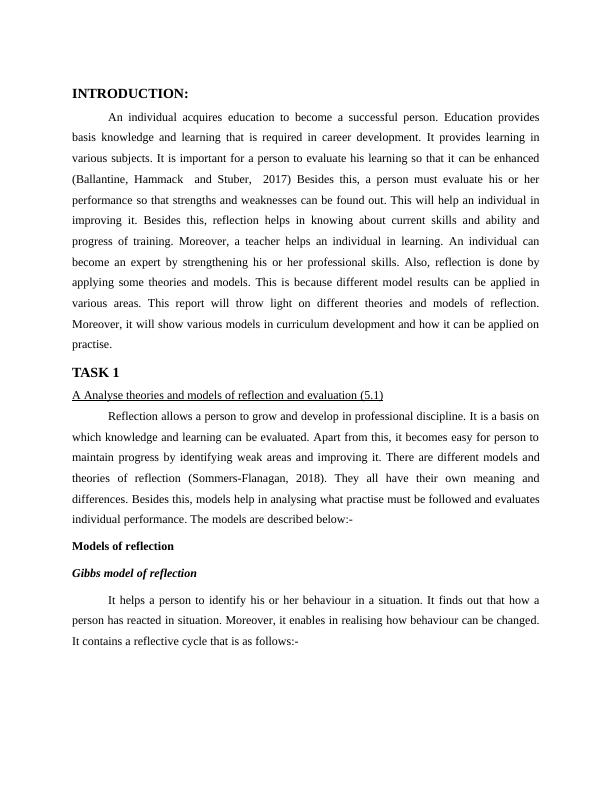
Step 1 description – It is the first stage in which situation is described in detail by aperson. Tutor asks several questions such as what happened, who were involved, whatyou did, etc. in that situation (Ngai, Moon and Tao, 2015) This gives a brief and clearview of entire situation. Step 2 feelings – This stage is related to feelings or experience of person during thatsituation. Tutor asks several questions in this like what he or she felt, what were otherfeelings, etc. Through this, a person is able to interact freely with tutor.Step 3 Evaluation – In this stage the entire situation is evaluated by tutor by analysingwhat positive and negative things occurred. It gives a clear view about root cause ofproblem. With this it becomes easy to find out solution of problem by focusing on rootcause.Step 4 conclusion- The solutions are implemented in this stage. It helps in reachingconclusion of problems. Tutor uses his or her skills and experience to solve provides.They collect as much information as available about situation.

Step 5 action – It is the last step. In this actions are developed in order to deal withsimilar situations in future. Beside this, it helps in identifying weak areas and reviewingprogress (Luke, 2018)Kolb’s model of reflection There are four stages in this model. In this learner internal cognitive process is identified.It helps in developing various concepts which can be used in dealing with different situations.The four stages are analysed below :-Concrete experience- This stage refers to learning from other experience and people.This is done by observing them and noticing what action were taken by them in aparticular situation to solve it. Reflective observation of new experience – in this person leans only by observingsituation. This is useful in properly analysing situation and finding out what can belearned from it. It also helps them in effective decision making and analysing things inbetter way.
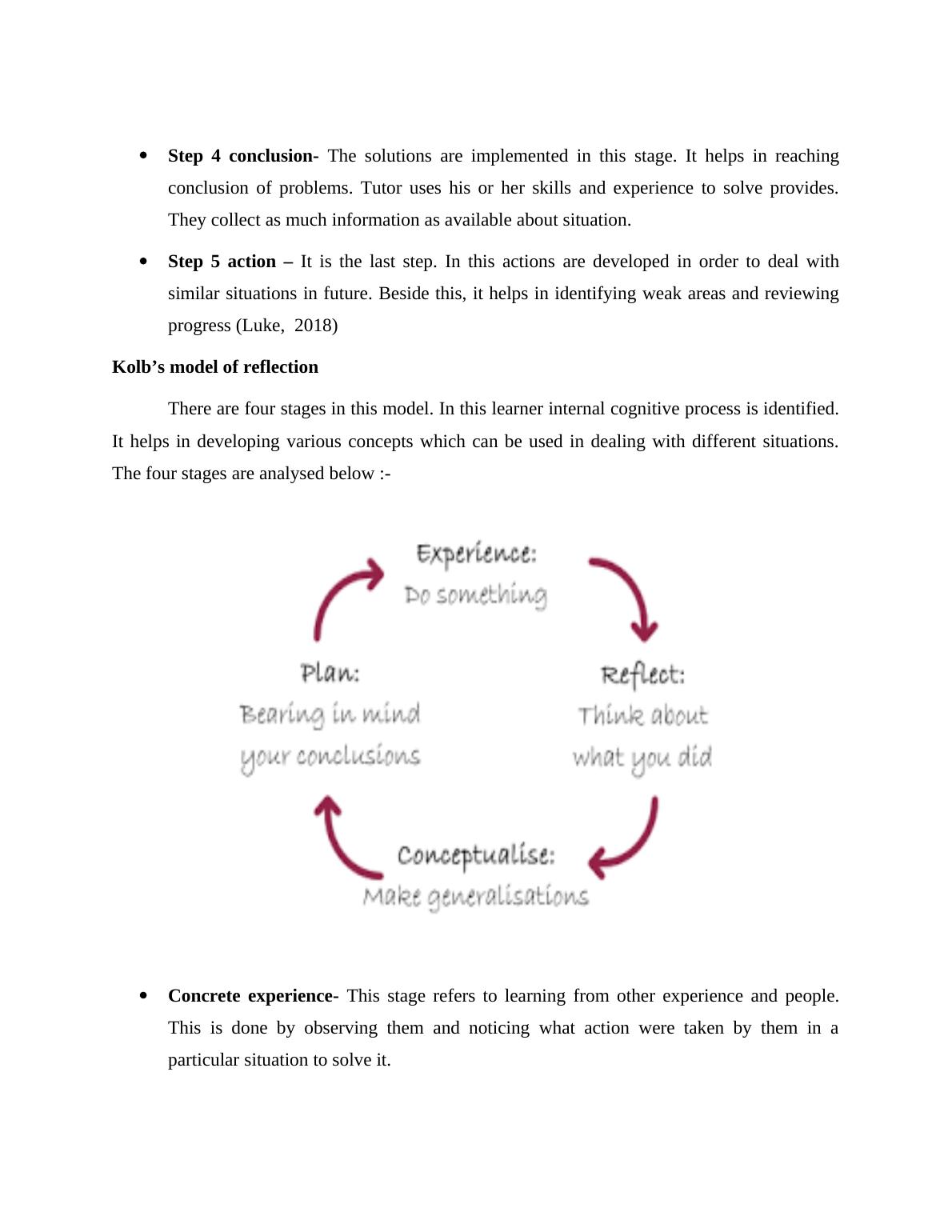
Abstract conceptualisation- This stage helps a person to think about situation so thatvarious ideas can be generated to solve it. Also, it enhances ability to understand situationin better way (Graham, Henrie and Gibbons, 2014)Active experimentation – In this stage experimentation is done to solve the problem.A person can apply these model of reflection that will help in evaluating performance. Bythis individual will be able to identify strength and weakness so that it can be improved.Moreover, these models can be used to improve behaviour of person. Apart from this, anindividual will be able to analyse and understand situation in better way. Also, tutor will helpperson to show ways in which problems can be solved (Marsick and Watkins, 2015) However,these models are applied only in particular situation. It is because each of them is having ownmeaning. B Theories and models of reflection can be applied to reviewing practice (5.2)An individual can apply these models in their practise. It will help them to grow anddevelop in respective field. Apart from this, models will completely change their behaviour andit will be easy for them to solve critical problems by analysing situation. In this way a person canmake improvements. This can be better understood from the following situations:- Gibbs reflective cycle- An incident happened during my summer vacations. I was staying withmy best friend in apartment. One day someone called and informed him that his brother has metwith an accident and died. It was very shocking news for me. In my life first time I faced thissituation. My friend was very nervous and tensed. So I helped and supported him. I helped inmaking him feel better. For this I tried to divert his mind. I have to understand the situation andtake any action. According to it I developed an action plan. It helped me to take better andeffective decisions. Kolb's model- In this an example can be taken when I was in college. I decided to play cricket.For this I need to get selected in college cricket team. There was a systematic procedure ofselecting a player. Somehow I got selected in college team. I played my first match. After that Irealised that I did not perform well. Since I was playing cricket from long time. I was expectingmuch better performance. I need to improve my timing to hit ball. I discussed it with team coach
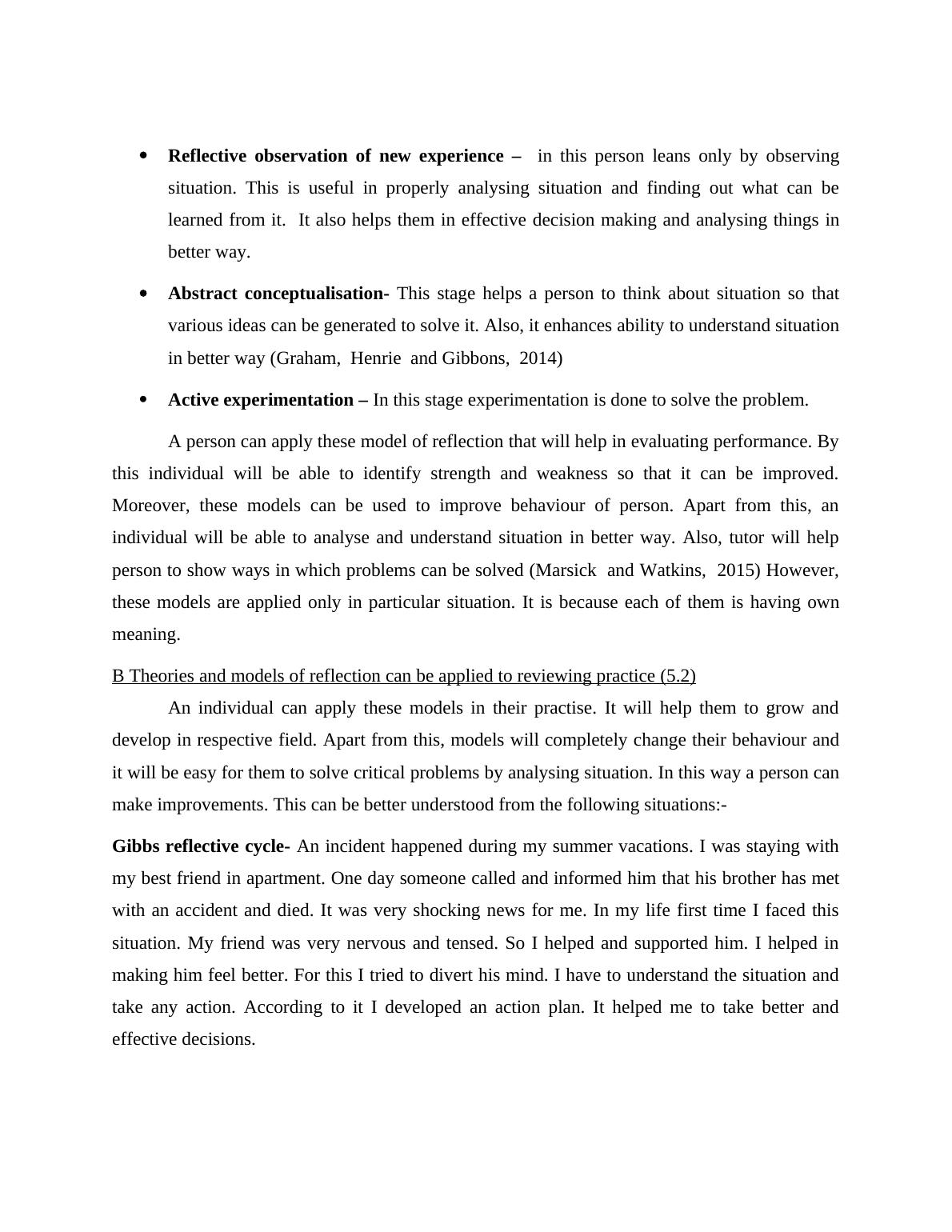
End of preview
Want to access all the pages? Upload your documents or become a member.
Related Documents
Theories, Principles and Models in Education and Learninglg...
|30
|9537
|180
Theories, Principles and models in education and Training (pdf)lg...
|22
|6364
|53
Theories, Principles and Models for Inspirational Teaching and Learninglg...
|18
|4709
|297
Unit 502: Theories, Principles and Models in Education and Traininglg...
|19
|6736
|471
Theories Models and Principles in E&T Assignmentlg...
|17
|5730
|252
Theories, Principles and Models in Education and Training: Assignmentlg...
|14
|4247
|464
